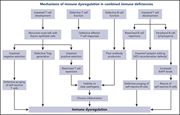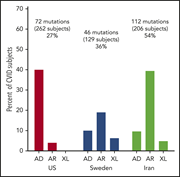Issue Archive
Table of Contents
EDITORIAL
BLOOD COMMENTARIES
PLENARY PAPER
Integrated drug profiling and CRISPR screening identify essential pathways for CAR T-cell cytotoxicity
In a study reported in this Plenary Paper, Dufva and colleagues used functional drug and CRISPR screens to uncover new biology about modulation of responses to chimeric antigen receptor (CAR) T-cell therapy. Their findings suggest that anti-CD19 CAR T-cell therapy can be enhanced through use of small molecules that target death receptor signaling.
REVIEW SERIES
Immune dysregulation in patients with RAG deficiency and other forms of combined immune deficiency
Clinical Trials & Observations
In this commissioned Review Series edited and introduced by Associate Editors Bollard and Stevenson, several experts contribute 6 seminal reviews, highlighting cutting-edge developments in the biology and management of primary immune deficiencies.
Virus-specific T-cell therapies for patients with primary immune deficiency
Clinical Trials & Observations
In this commissioned Review Series edited and introduced by Associate Editors Bollard and Stevenson, several experts contribute 6 seminal reviews, highlighting cutting-edge developments in the biology and management of primary immune deficiencies.
A research-driven approach to the identification of novel natural killer cell deficiencies affecting cytotoxic function
Clinical Trials & Observations
In this commissioned Review Series edited and introduced by Associate Editors Bollard and Stevenson, several experts contribute 6 seminal reviews, highlighting cutting-edge developments in the biology and management of primary immune deficiencies.
Increased activation of PI3 kinase-δ predisposes to B-cell lymphoma
Clinical Trials & Observations
In this commissioned Review Series edited and introduced by Associate Editors Bollard and Stevenson, several experts contribute 6 seminal reviews, highlighting cutting-edge developments in the biology and management of primary immune deficiencies.
Primary immunodeficiencies reveal the molecular requirements for effective host defense against EBV infection
In this commissioned Review Series edited and introduced by Associate Editors Bollard and Stevenson, several experts contribute 6 seminal reviews, highlighting cutting-edge developments in the biology and management of primary immune deficiencies.
Current genetic landscape in common variable immune deficiency
Clinical Trials & Observations
In this commissioned Review Series edited and introduced by Associate Editors Bollard and Stevenson, several experts contribute 6 seminal reviews, highlighting cutting-edge developments in the biology and management of primary immune deficiencies.
IMMUNOBIOLOGY AND IMMUNOTHERAPY
Specific stimulation of T lymphocytes with erythropoietin for adoptive immunotherapy
Using a novel approach, Vinanica and colleagues revealed that the persistence and efficacy of CAR T-cells in preclinical studies can be enhanced by ectopic expression of a highly active mutant form of the erythropoietin receptor.
MYELOID NEOPLASIA
Molecular MRD status and outcome after transplantation in NPM1-mutated AML
Clinical Trials & Observations
Detection of mutant NPM1 measurable residual disease (MRD) in patients with normal karyotype acute myeloid leukemia (AML) after standard therapy portends relapse and is an indication for allografting. Dillon and colleagues now report that the levels of pretransplant NPM1 MRD are highly predictive of posttransplant outcomes, and they propose that high- and low-risk groups can be identified.
THROMBOSIS AND HEMOSTASIS
The protein C activator AB002 rapidly interrupts thrombus development in baboons
Clinical Trials & Observations
Tucker and colleagues report that the recombinant thrombin mutant AB002 (E-WE thrombin) in baboons can rapidly interrupt acute vascular graft thrombus propagation and prevent arterial thrombo-occlusion. Intravenous administration to normal volunteers appears to be safe, leading the authors to recommend its clinical evaluation as a novel antithrombotic.
BLOOD WORK
-
Cover Image
Cover Image
![issue cover]()
Confocal microscopy of a natural killer cell–target conjugate. Notice the F-actin (white) accumulation at the synapse and lytic granule (perforin [green]) convergence around the microtubule-organizing center (α-tubulin [red]) along with polarization toward the target (cyan). See the article by Lam et al on page 629.
- PDF Icon Front MatterFront Matter
- PDF Icon Table of ContentsTable of Contents
- PDF Icon Back MatterBack Matter
- PDF Icon Editorial BoardEditorial Board
Advertisement intended for health care professionals
Email alerts
Advertisement intended for health care professionals













Supercharging your CAR